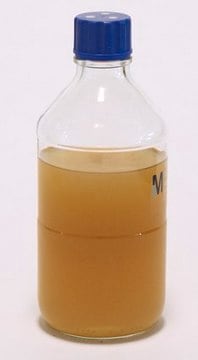442521
Chloropicrin
analytical standard
Synonyme(s) :
Trichloronitromethane, Chloropicrine
About This Item
Produits recommandés
Qualité
analytical standard
Conditionnement
ampule of 100 mg
Technique(s)
HPLC: suitable
gas chromatography (GC): suitable
Indice de réfraction
n20/D 1.461 (lit.)
Point d'ébullition
112 °C (lit.)
Densité
1.657 g/mL at 25 °C (lit.)
Application(s)
agriculture
environmental
Format
neat
Température de stockage
2-8°C
Chaîne SMILES
[O-][N+](=O)C(Cl)(Cl)Cl
InChI
1S/CCl3NO2/c2-1(3,4)5(6)7
Clé InChI
LFHISGNCFUNFFM-UHFFFAOYSA-N
Vous recherchez des produits similaires ? Visite Guide de comparaison des produits
Description générale
Sigma-Aldrich offers chloropicrin for a variety of applications that include, but are not limited to, environmental, food and beverage, forensics, petrochemical and pharmaceutical analysis.
Application
Mention d'avertissement
Danger
Mentions de danger
Conseils de prudence
Classification des risques
Acute Tox. 2 Inhalation - Acute Tox. 3 Oral - Aquatic Acute 1 - Aquatic Chronic 1 - Eye Irrit. 2 - Skin Irrit. 2 - Skin Sens. 1 - STOT SE 3
Organes cibles
Respiratory system
Code de la classe de stockage
6.1A - Combustible acute toxic Cat. 1 and 2 / very toxic hazardous materials
Classe de danger pour l'eau (WGK)
WGK 1
Point d'éclair (°F)
Not applicable
Point d'éclair (°C)
Not applicable
Équipement de protection individuelle
Eyeshields, Faceshields, Gloves, type ABEK (EN14387) respirator filter
Choose from one of the most recent versions:
Déjà en possession de ce produit ?
Retrouvez la documentation relative aux produits que vous avez récemment achetés dans la Bibliothèque de documents.
Notre équipe de scientifiques dispose d'une expérience dans tous les secteurs de la recherche, notamment en sciences de la vie, science des matériaux, synthèse chimique, chromatographie, analyse et dans de nombreux autres domaines..
Contacter notre Service technique










